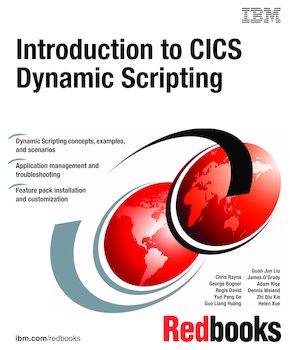
Published on 28 March 2011, updated 30 June 2011
Read in Google Books Order hardcopy
Share this page:
ISBN-10: 073843552X
ISBN-13: 9780738435527
IBM Form #: SG24-7924-00
Authors: Chris Rayns, George Bogner, Regis David, Yun Peng Ge, Guo Liang Huang, Guan Jun Liu, James O'Grady, Adam Rice, Dennis Weiand, Zhi Qiu Xie and Helen Xue
Abstract
IBM® CICS® Transaction Server Feature Pack for Dynamic Scripting embeds and integrates technology from WebSphere® sMash into the CICS TS V4.1 run time, helping to reduce the time and cost of CICS application development. The Feature Pack provides a robust, managed environment for a wide range of situational applications allowing PHP and Groovy developers to create reports, dashboards, and widgets, and integrate CICS assets into mash-ups, and much more.
The CICS Dynamic Scripting Feature Pack combines the benefits of scripted, Web 2.0 applications with easy and secure access to CICS application and data resources. The Feature Pack includes a PHP 5.2 run time implemented in Java™ and with Groovy language support, support for native Java code and access to many additional libraries and connectors to enhance the development and user experience of rich Internet applications. Access to CICS resources is achieved by using the JCICS APIs.
In this IBM Redbooks® publication, we introduce the Dynamic Scripting Feature Pack, show how to install and customize it, and provide examples for using it.
Table of Contents
Part 1. Technology introduction
Chapter 1. Dynamic Scripting overview
Chapter 2. Project Zero and WebSphere sMash features and capabilities overview
Chapter 3. Web 2.0
Chapter 4. Web 2.0 technologies
Part 2. Systems management
Chapter 5. Installation
Chapter 6. Customizing CICS Dynamic Scripting Feature Pack
Chapter 7. Administration
Chapter 8. Troubleshooting
Chapter 9. Dynamic Scripting for unit testing of CICS programs
Part 3. Scenarios
Chapter 10. Development options
Chapter 11. Derby and DB2, create easy example
Chapter 12. Dynamic scripting scenarios
Chapter 13. Command-line sample